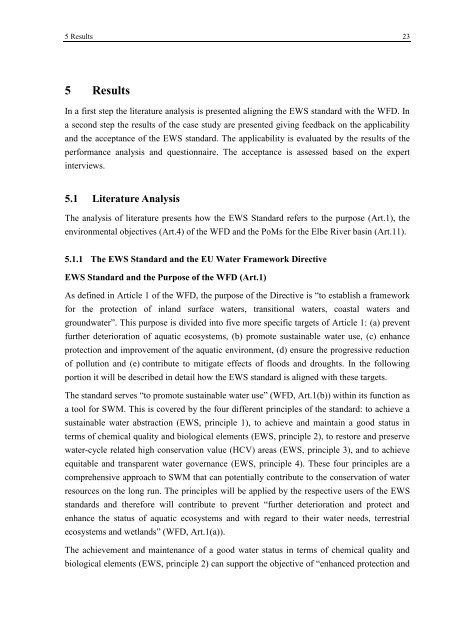Assessing the European Water Stewardship Standard in the Context ...
Assessing the European Water Stewardship Standard in the Context ...
Assessing the European Water Stewardship Standard in the Context ...
Create successful ePaper yourself
Turn your PDF publications into a flip-book with our unique Google optimized e-Paper software.
5 Results 23<br />
5 Results<br />
In a first step <strong>the</strong> literature analysis is presented align<strong>in</strong>g <strong>the</strong> EWS standard with <strong>the</strong> WFD. In<br />
a second step <strong>the</strong> results of <strong>the</strong> case study are presented giv<strong>in</strong>g feedback on <strong>the</strong> applicability<br />
and <strong>the</strong> acceptance of <strong>the</strong> EWS standard. The applicability is evaluated by <strong>the</strong> results of <strong>the</strong><br />
performance analysis and questionnaire. The acceptance is assessed based on <strong>the</strong> expert<br />
<strong>in</strong>terviews.<br />
5.1 Literature Analysis<br />
The analysis of literature presents how <strong>the</strong> EWS <strong>Standard</strong> refers to <strong>the</strong> purpose (Art.1), <strong>the</strong><br />
environmental objectives (Art.4) of <strong>the</strong> WFD and <strong>the</strong> PoMs for <strong>the</strong> Elbe River bas<strong>in</strong> (Art.11).<br />
5.1.1 The EWS <strong>Standard</strong> and <strong>the</strong> EU <strong>Water</strong> Framework Directive<br />
EWS <strong>Standard</strong> and <strong>the</strong> Purpose of <strong>the</strong> WFD (Art.1)<br />
As def<strong>in</strong>ed <strong>in</strong> Article 1 of <strong>the</strong> WFD, <strong>the</strong> purpose of <strong>the</strong> Directive is “to establish a framework<br />
for <strong>the</strong> protection of <strong>in</strong>land surface waters, transitional waters, coastal waters and<br />
groundwater”. This purpose is divided <strong>in</strong>to five more specific targets of Article 1: (a) prevent<br />
fur<strong>the</strong>r deterioration of aquatic ecosystems, (b) promote susta<strong>in</strong>able water use, (c) enhance<br />
protection and improvement of <strong>the</strong> aquatic environment, (d) ensure <strong>the</strong> progressive reduction<br />
of pollution and (e) contribute to mitigate effects of floods and droughts. In <strong>the</strong> follow<strong>in</strong>g<br />
portion it will be described <strong>in</strong> detail how <strong>the</strong> EWS standard is aligned with <strong>the</strong>se targets.<br />
The standard serves “to promote susta<strong>in</strong>able water use” (WFD, Art.1(b)) with<strong>in</strong> its function as<br />
a tool for SWM. This is covered by <strong>the</strong> four different pr<strong>in</strong>ciples of <strong>the</strong> standard: to achieve a<br />
susta<strong>in</strong>able water abstraction (EWS, pr<strong>in</strong>ciple 1), to achieve and ma<strong>in</strong>ta<strong>in</strong> a good status <strong>in</strong><br />
terms of chemical quality and biological elements (EWS, pr<strong>in</strong>ciple 2), to restore and preserve<br />
water-cycle related high conservation value (HCV) areas (EWS, pr<strong>in</strong>ciple 3), and to achieve<br />
equitable and transparent water governance (EWS, pr<strong>in</strong>ciple 4). These four pr<strong>in</strong>ciples are a<br />
comprehensive approach to SWM that can potentially contribute to <strong>the</strong> conservation of water<br />
resources on <strong>the</strong> long run. The pr<strong>in</strong>ciples will be applied by <strong>the</strong> respective users of <strong>the</strong> EWS<br />
standards and <strong>the</strong>refore will contribute to prevent “fur<strong>the</strong>r deterioration and protect and<br />
enhance <strong>the</strong> status of aquatic ecosystems and with regard to <strong>the</strong>ir water needs, terrestrial<br />
ecosystems and wetlands” (WFD, Art.1(a)).<br />
The achievement and ma<strong>in</strong>tenance of a good water status <strong>in</strong> terms of chemical quality and<br />
biological elements (EWS, pr<strong>in</strong>ciple 2) can support <strong>the</strong> objective of “enhanced protection and


